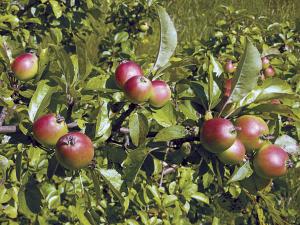Wild Sweet Crabapples are beautiful late bloomers
There is something to be said for late bloomers. After arthritis forced Anna Mary Robertson Moses to give up her longtime hobby of embroidering, she took up painting at the age of 75. She sold her paintings for $2 for the smaller ones and $3 for the larger paintings. Fame awaited.
When a new interstate doomed his restaurant, Harlan David Sanders took to the road selling his method of cooking chicken and founded Kentucky Fried Chicken. He was 65.
After plying her trade as a manicurist in a bit part for a commercial filmed in a barbershop, the woman with the gravelly voice was plucked up by an ad agency so that at age 81 she made her first of many national commercials. It was for Wendy’s and her catchphrase “Where’s the beef?” made Clara Peller a sensation.
Late bloomers do their best work late in life, and late bloomers in the garden are no exception. Late-blooming plants extend the season, and let us enjoy a long goodbye. And some late bloomers surpass all in their field and put on the best show of all.
So when spring gives us the richly fragrant, stunning blooms of crabapple trees, it is always sad to see the them fade. There is one late bloomer in the crabapple family that not only extends the flowering season, but does it in a shocking display that is perhaps the best flowering crabapple around. And it has delicious fruit as well.
The Wild Crabapple (Malus coronaria), sometimes called Wild Sweet Crabapple, is a 20- to 30-foot-tall tree with a spread of 15 to 25 feet. The pink buds open in April or May into single, rose flowers with white highlights. The blooms are clustered in groups of five or six, making one of the most spectacular sights in the garden.
The violet-scented blooms give way to small one-inch diameter fruit that ripens to a yellow-green color from September through November. Crabapples are any apples under two inches. These fragrant crabapples often stay on the tree long after its leaves have fallen. Wild Sweet Crabapples provide wildlife with food throughout the winter into early spring.
You can plant Wild Sweet Crabapple just about any time of the year if you buy “balled and burlapped” (B&B) trees or potted trees available at nurseries and garden centers. These trees go through less transplant shock than bare root trees often sold by mail order. If you plant bare root trees they do best planted in early spring. Soak all bare root trees in a bucket of water for three to six hours to rehydrate the roots. Properly planted and watered, bare root trees often catch up in growth with potted or balled and burlapped trees.
If you cannot find Wild Sweet Crabapples locally, ask your garden center to order for you or try a mail-order nursery such as Musser Forests (www.musserforests.com) or Fedco Seeds (www.fedcoseeds.com or PO Box 520, Waterville ME 04903).
Plant Wild Sweet Crabapples in full sun for best flower display and fruit production. They adapt well to a wide range of soils but prefer well-drained acidic soil with a pH of 5.0 to 6.5. Unfortunately the Wild Sweet Crabapple is vulnerable to cedar-apple rust so should be planted well away from Red Cedar trees (Juniperus virginiana) which can spread cedar-apple rust.
They usually need little if any pruning, but if you must cut any limbs do it before early June to allow the tree to recover before winter.
This American native tree does equally well in a woodland as in an urban area. They are hardy in USDA Zones 4-7. Wild Sweet Crabapple trees (Malus coronaria) make a stunning display covered in huge billows of pink-white blooms, and are used in parks, along city streets and highways.
And what came of that late bloomer Anna Mary Robertson Moses? Better known as Grandma Moses, her painting “Sugaring Off” sold for $1.2 million. Proving that for late-blooming people and late-blooming crabapples, the best is yet to come.




















































